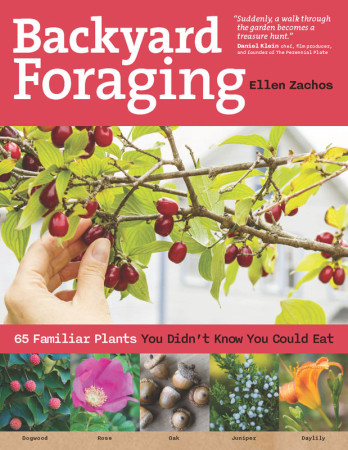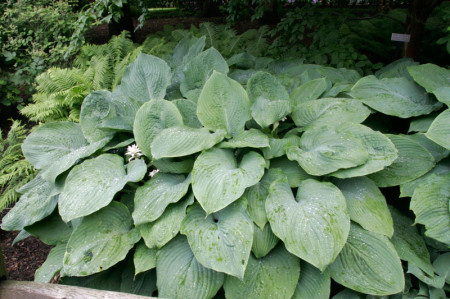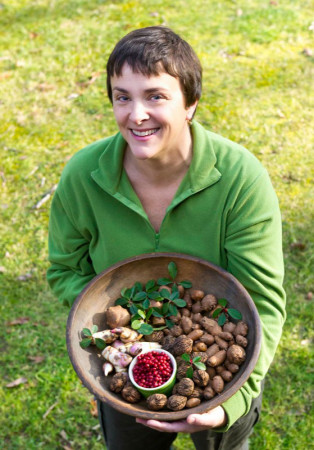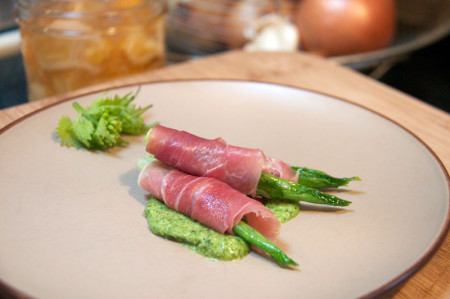 Did you know that hosta—the large-leaved and oft variegated landscaping plant that the deer love so much—is edible? I had no idea until I picked up Ellen Zachos’ book, Backyard Foraging: 65 Familiar Plants You Didn’t Know You Could Eat (Storey Publishing, 2013). Go figure.
Did you know that hosta—the large-leaved and oft variegated landscaping plant that the deer love so much—is edible? I had no idea until I picked up Ellen Zachos’ book, Backyard Foraging: 65 Familiar Plants You Didn’t Know You Could Eat (Storey Publishing, 2013). Go figure.
The funny thing is that for as long as I can remember, my mom has planted hosta in the rock garden and other places around my childhood home in Connecticut. Every year it’s a battle, because every year the deer eat it. Now Mom will have to protect her hosta from one more pest.
Zachos explains that hostas come in many different colors and cultivars—all edible, though they may vary in flavor. For this reason, she recommends trying a nibble here and there to see which ones you like best, noting that in Japan, the young shoots of Hosta sieboldii are skinned, parboiled, chopped, and served over rice; in northern Japan, H. montana is grown in greenhouses and kept covered to blanch and tenderize the foliage.
“What’s for dinner?” she asks. “Boiled hosta with miso mustard sauce, of course,” she writes, answering her own question.
New, tight shoots are good chopped, stir-fried, and served over pasta or rice, Zachos writes. The mature leaves, on the other hand, should be boiled for 15-20 minutes, then “chopped and sautéed like other greens, in soups or baked in a quiche or pie.”
Edible Landscaping

Unlike many foraging guides that focus on edible weeds and native species, Backyard Foraging invites readers to view ornamental gardens and landscaping from a forager’s perspective, seeing plants—from groundcover green to exotic fruit tree—as interesting ingredients with a place in the kitchen.
Among the plants she recommends eating are bamboo (Phylostachys spp.), bishop’s weed or goutweed (Aegopdium podagraria), spiderwort (Tradescantia virginiana), sweetfern (Comptonia peregrina), strawberry tree (Arbutus unedo), firethorn (Pyracantha cocinea), and dahlia tubers (Dahlia spp.).
I was happy to find entries for some of the plants I’ve been interested in of late, including mountain ash or rowan berries (Sorbus spp.), bee balm (Monarda didyma and M. fistulosa), California bay (Umbellularia californica), nasturtium (Tropaeolum majus), wintergreen (Gaultheria procumbens), kousa dogwood (Cornus kousa), spicebush (Lindera benzoin), and sassafras (Sassafras albidum).
She also includes some common weeds that you are unlikely to plant, but likely to recognize and consider consuming. Some are more likely to be found in one region than another. Zachos is based in the northeastern United States, but she covers a few that are found elsewhere, such as miner’s lettuce (Claytonia perfoliata syn. Montia perfoliata), which is found primarily in the western U.S. towards the coast.

Gardeners, Take Note
I would say Backyard Foraging is best described as light reading, rather than a scientific journey through plants. If you don’t know the plants already, you’ll probably want to pair it with an ID guide or three to help with identifying characteristics and geographical ranges.
The introduction covers foraging basics—with topics like where to forage, allergy information, and ethical harvesting—before closing with a cute “Foraging Quiz” to make sure you learned the material. The first chapter takes a look at foraging by habitat, asking questions like, “Are you standing on a mowed lawn?” that the author then answers: “Get down on your hands and knees to look for sheep sorrel, chickweed, dandelion, and pineapple weed.” The print is on the big side, and there are many clear, attractive, full-color photos interspersed throughout the colorful, easy-to-read layout, helping make the topic accessible to a broad range of readers.
Backyard Foraging would make a good gift for gardeners interested in foraging but nervous about getting their plant ID’s correct without expert guidance, because they are likely to know quite a few of the plants already. I mean, if there’s one plant my mom knows, it’s hosta—even though she is still uncertain about identifying edible docks and garlic mustard on her own.
Zachos is the author of several books on gardening, and she shares that expertise in Backyard Foraging. In addition to edibility information, there are gardening tips for each plant, like where and how to plant a given species, whether or not it is likely to be an aggressive volunteer, and how to control it if so. She recommends her favorite tools for digging and trimming, and includes a basic how-to section on various methods for preserving foods, from jellies, jams, and syrups to booze, baked goods, and savory dishes, along with a handful of recipes.
Use Bishop’s Weed in Greek Food

Zachos writes how her yiayia (her grandmother) grew up in the mountains of central Greece, where wild edibles were an important part of village diets. She recommends trying the leaves of the aggressive landscaping plant, bishop’s weed, as a filling for Greek “pita,” or pie. Her recipe for hortopita, a less well-known cousin to spanakopita, involves an ensemble of phyllo dough, wild greens to replace the spinach, feta cheese, cottage cheese or Greek yogurt, and eggs.
“I planted bishop’s weed in several places when we moved into our house, well aware that most people think of it as a bully in the garden,” she writes, noting that garden centers still sell the variegated variety despite the fact that the plant is listed as a noxious weed in 46 states. “I needed ground cover and I needed it fast,” she explains. “While some people might consider this a mistake, I went in with my eyes wide open. I knew it was a garden thug, but I also knew I could eat it.”
Among the recipes, I am excited to try the mushroom ravioli and her milkweed flower syrup; the latter can be used to make Asclepias sorbet.
One Day
As for me, I’ve never had a garden. In my adult life, I’ve never had a plot of land to call my own. Everything I know about cultivated plants is through their wild relatives. To be honest, the idea of gardening scares me a little, but that doesn’t keep me from looking forward to that glorious day. When it arrives, I’ll be glad to have Ellen Zachos’ book on hand.

*This story originally appeared in the June 2014 issue of the Wild Edible Notebook, available for the screaming deal of just $2/month, including 6 issues when you sign up. Please, universe, let there be enough sign-ups so I can quit all my other jobs that keep me from writing. Just don’t tell my bosses.

Leave a Reply